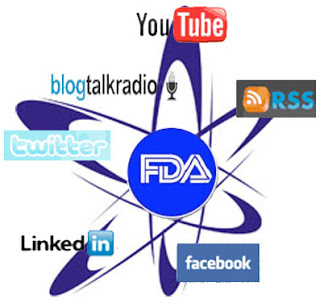 The US Food and Drug Administration (FDA) today issued a new guidance document that addresses the use of “social media” by pharmaceutical companies.
The US Food and Drug Administration (FDA) today issued a new guidance document that addresses the use of “social media” by pharmaceutical companies.
I’m very excited about this and look forward to seeing the details. I note, however, that acting FDA Commissioner, Dr. Joshua M. Sharfstein, implied a “carrot and stick” approach to regulating pharma social media marketing.
See the press release posted below for more information. [BE SURE TO READ TO THE VERY END.]
——————————————
FOR IMMEDIATE RELEASE
P04-12
April 1, 2009
Media Inquiries: 301-827-6242
Consumer Inquiries: 888-INFO-FDA
New FDA Draft Guidance Aims to Improve Health Information Obtained via “Social Media” Websites
The Food and Drug Administration today issued a draft guidance document designed to improve communications to consumers and health care practitioners about health conditions and medical products that they obtain on “social media” Websites such as Facebook, YouTube, Twitter and online bulletin boards. The guidance is the result of FDA research and policy development, and was influenced by the success of the recent social media based peanut recall program (see http://tinyurl.com/d3lvag).
“We intend to do all we can under the law to make sure that the information conveyed by prescription drug promotion is as useful as possible,” said acting FDA Commissioner, Dr. Joshua M. Sharfstein. “Our new regulatory guidance provides new direction to sponsors on how to provide higher-quality health information to the public via social media sites, based on recent evidence on what works and what doesn’t. The evidence shows that social media promotions directed to consumers can play an especially important role in helping patients start a discussion about conditions that are often unrecognized and therefore undertreated, such as diabetes, high blood pressure, high cholesterol, depression, and obesity. And we think those discussions should reflect a better understanding of the key risks and benefits of a product. Without participation by pharmaceutical companies in those discussions, there is increased likelihood of false or dangerous information being promulgated throughout the Internet.”
According to an FDA study, a majority of interactive agencies surveyed feel that social media product messages increase patient awareness and involvement, and improve compliance. That study also shows that social media-stimulated visits to a physician can help identify a previously undiagnosed condition. Importantly, of patients who visited their doctors because of an online discussion they participated in, 95% actually had the condition the drug treats. That percentage was even greater than that reported among patients who viewed DTC ads on TV.
The draft guidance provides (1) a simple method by which sponsors can insert a notice about reporting adverse events in their posts to social media sites, (2) “safe harbor” conditions that relieve manufacturers of responsibility for reporting adverse events they may hear about on social media sites, and (3) advice for manufacturers on the types of branded and unbranded communications that fall under the rules set forth in the guidance.
“Clear, evidence-based regulatory guidance will help FDA use its limited resources to police the marketplace as effectively as possible,” said Sharfstein. “FDA will take action against sponsors whose ads violate the law by presenting false or misleading information to the public via social media sites. Our new draft guidance is intended to help responsible companies comply, for the benefit of the public health. If they don’t, we now have an even stronger basis for pursuing enforcement actions.”
“Improving our nation’s health literacy a critical step in improving our nation’s health,” said Jean-Ah Kang, special assistant to director Tom Abrams. Kang was tasked with developing policy on pharma social media marketing and was responsible for the social media communications that was instrumental in the success of the recent peanut recall program. “More and more patients are seeking health information online and through social networks of their peers. The FDA’s new guidance will help empower these patients with accurate information from manufacturers rather than relying upon unsubstantiated claims made by anonymous online sources. It’s also way cool.”
The draft guidance document is part of FDA’s strategic social media plan, one goal of which is to help create better-informed consumers. To access FDA’s strategic plan go to http://tinyurl.com/c5jyaf
The Social Media draft guidance document is available online (see links below). FDA encourages public comment on these documents.
####
FDA’s Use of Social Media: http://tinyurl.com/d3lvag
Consumer-Directed Social Media Promotion of Prescription Drugs: http://bit.ly/eJlk
——————-
THIS IS A FAKE PRESS RELEASE
I apologize that many people did not realize this was a prank designed to raise awareness of an important issue (see follow-up post: “FDA and Pharma – Bring More Stakeholders into Your Discussion of Social Media Guidelines! No More Joking!“).
I had thought that the phrase “way cool” attributed to Jean-Ah Kang PLUS the links would have given it away.
Unfortunately, a few people did not catch those hints.








![6 Digital Tools at the Center of Healthcare Digitalization [INFOGRAPHIC]](http://ec2-54-175-84-28.compute-1.amazonaws.com/pharma-mkting.com/wp-content/uploads/2021/04/6DigitalTools_600px-100x70.jpg)




